-

人教版新目标初中英语八年级下册Have you ever been to an amusement park教案
(1)Have you ever been to …? Yes, I have. / Yes, I have ever been to …No, I haven’t. / No, I have never been to …(2)When did you go there? I went there last year. (3)I have never been to a water park. Neither have I. I have ever been to an amusement park. So have I. (4)How long have you been studying English? I’ve been studying English since nine o’clock. I’ve been studying English since I came back home. I’ve been studying English for five hours. (5)What’s that? It’s an amusement park in Japan. I’ve never been to an amusement park like it before. It’s fun to learn another language. Let’s go tonight. Isn’t this great?space museum, amusement park, water park, South America, Peru, Holland, European culture, tour guide, flight attendant, musical instrument, more than, be from, get to, take lessons, neither, discover, graduate, change

人教版新目标初中英语八年级下册Why don’t you get her a scarf教案
教师带领学生复习有关描述宠物的词汇,采用教师提问学生回答的方进行。如:T:What animals do you think would be good pets?What animals do you think would be bad pets?What do you think are good animals for a six-year-old child?然后学生进行 pairwork 练习。Task two: 师生互动,学习探究 1、播放3a部分的录音,引导学生一边听录音,一边跟读。2、通过听录音学生回答以下问题:Why do you think pot-bellied pigs are popular?What are the advantages and disadvantages of keeping such a pet?教师对学生的回答进行及时点评。3.学习范文,学习重点短语,为下步的模仿写作提供语言素材。T :1. )Have you ever kept a pig as a pet?Do you like pigs? St.:No.…Why don’t you like to keep a pig? St: No.They’re too dirty and lazy(Do you know in some foreign countries like Hollyland, Australia,pigs are the most popular pet.there’s a kind of pig.(图)it has an interesting name? it ‘s called a pot-bellied pig.) Now,let’s learn an article about this kind of interesting pet.2.)play the tapeSt.:Listen and repeat3.)show some Qs on computer(本子St.: read silently,then answerthe Qs(本子)4.)Ask ss. Close book and retell this passage.(what is a pot-bellied pig? Is it a good or bad pet? ) St.: retell it to each other“A pot –bellied pig is a popular pet now…”5.read the article together.St.:.practice reading

人教版新目标初中英语八年级下册Would you mind turning down the music教案
Step 4. Group work (4)1. Ask a pair of students to read the dialogue. Say, This activity provides speaking, listening and writing practice using the target language.2. Ask students to complete the work in groups.3. Check the answers with the whole class. 4. Explain some of the language points. Step 5. Word review (Self check 1)1. Ask students to read the words and the phrases given. 2. Fill in the blanks with proper forms of these words to complete the sentences. 3. Check the answers with the whole class. Homework:Do activity 2 on page 57 after class. Period 6Teaching aims: 1. Teach vocabulary words and the useful expressions. 2. Enable the students to learn etiquette in different culture. 3. Help the students learn how to behave politely in public places and in daily life. Teaching procedures:Step 1. RevisionHelp students to review the function of making requests through a free talk. Then lead them to the topic of etiquette. Explain the meaning of etiquette. Or, ask students to look it up in the dictionary. Step 2. Pre-reading (Section 1)1. Ask students to read the picture and make a list with their partner about how many rules of etiquette can be seen being broken.
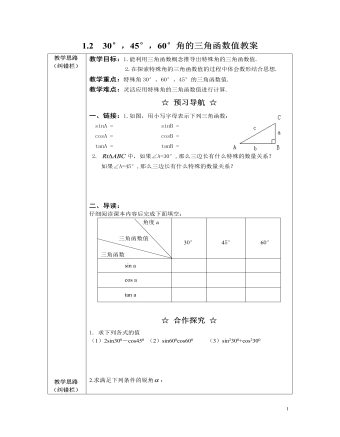
北师大初中九年级数学下册30°,45°,60°角的三角函数值2教案
教学目标:1.能利用三角函数概念推导出特殊角的三角函数值.2.在探索特殊角的三角函数值的过程中体会数形结合思想.教学重点:特殊角30°、60°、45°的三角函数值.教学难点:灵活应用特殊角的三角函数值进行计算.☆ 预习导航 ☆一、链接:1.如图,用小写字母表示下列三角函数:sinA = sinB =cosA = cosB =tanA = tanB =2. 中,如果∠A=30°,那么三边长有什么特殊的数量关系?如果∠A=45°,那么三边长有什么特殊的数量关系?二、导读:仔细阅读课本内容后完成下面填空:

人教版新目标初中英语九年级下册By the time I got outside, the bus had already left教案
Ⅰ. Teaching Aims and Demands1. Knowledge Objects(1) Key Vocabularyoversleep(2) Target LanguageWhat happened?I overslept. And by the time I got up, my brother had already gotten in the shower.2. Ability Objects(1) Teach the students to use the new words.(2) Train the students to narrate past events with the Past Perfect Tense.(3) Train the students' listening and speaking skills with the target language.3. Moral ObjectIt’s a good habit to go to bed early in the evening and get up early in the morning. So you’ll never be in a hurry in the morning.Ⅱ. Teaching Key Points1. Key Vocabularyoversleep2. Target LanguageNarrate past events with the Past Perfect TenseⅢ. Teaching Difficult Points1. Train the students to narrate past events with the Past Perfect Tense.2. Train the students to understand the target language in spoken conversation.Ⅳ. Teaching Methods1. Thinking of examples from the students' real lives.2. Making sentences by looking at the pictures.Ⅴ. Teaching AidA tape recorderⅥ. Teaching ProceduresStep I Revision1. Revise the language points in Unit 8.Ask some questions like this: What volunteer work would you like to do?Help the students to answer, I’d like to…/I love to…/I hope to2. Practice the dialogue in Activity 3c on page 62 again. Get students to role play the similar dialogues with the following.

人教版新目标初中英语九年级下册Rainy days make me sad教案
1. 教材分析本单元以how do things affect you?为话题, 从颜色、天气、音乐、广告、产品等方面谈论了外界事物如何影响人的心情。要求学生掌握表达某物或某事给人带来的感觉、看法或影响等。共设计了四个部分的内容:Section A 该部分有4个模块:第一模块围绕Which restaurant would you like to go to?这一话题展开思维(1a)、听力(1b)、口语(1c)训练;第二模块围绕How does music affect you? 进行听力(2a-2b)、口语训练(2c);第三模块继续围绕how do colors in the restaurant affect you这一话题展开训练,训练形式为阅读和问题体验(3a)和小组活动(3b);第四模块仍就How do things affect you这一话题以调查的形式展开讨论。Section B该部分有4个模块:第一模块围绕产品广告对人们的影响这一话题以“配对”(1a)与“列举”(1b)两种形式展开训练;第二模块继续围绕How do things affect you? 进行听力(2a-2b)、口语对话训练(2c);第三模块围绕“Advertising”这一话题展开阅读(3a-3b)和写作(3c)训练;第四模块围绕How posters affect you这一话题以口语训练形式展开小组活动。

人教版新目标初中英语九年级下册Could you please tell me where the restrooms are教案
Step Ⅰ RevisionCheck homework. Ask a few students to read the article in 3a.Then ask a few students to read their guides.Step Ⅱ Part 1Look at the words in the box. Ask a student to read them. Make sure the students understand the meaning of the words. You are to fill in the blanks with the words. In some cases, students may need to use another form of the word, for example adjusting for tense or subject/ verb agreement.Ask students to fill in the blanks on their own.Check the answers. Step ⅢPart 2Go through the instructions with the class.Look at the example with the students.Ask students what the answer would be.Ask a student to read the question and answer it.Excuse me, could you tell me where the bank is, please?The bank is across the street from the shopping malt.Get students to complete the work in pairs.Check the answers. Ask a few students to read their questions.Step Ⅳ Just for Fun!Ask all the students to read the conversation. Ask: What is funny about this cartoon? Help students to explain. A Martian is a person from the planet Mars.There is no such thing as Martian food on Earth, and the clerk looks silly because he is trying to think of where there is a Martian restaurant.Invite some pairs of students to present this conversation to the rest of the class.Step Ⅴ Summary and HomeworkIn this class, we’ve done much writing practice using the key vocabulary words and the target language presented in this unit. After class, please finish the questions in 2 in your exercise books. Then finish the exercises on pages 47~48 of the workbook as well.The Seventh Period Ⅰ Teaching Aims and Demands1. Knowledge Objects(1) Key Vocabularyimage, adventure, jealousy, hero, crime, journey, brave, no longer, show interest in, take it easy, become interested in, plain looks(2)Text:Grown-ups like cartoons, too.2. Ability Objects(1) Fast-reading to get a general idea of the text.(2) Careful-reading to get the detailed information in the text.

人教版新目标初中英语九年级下册I’ll help clean up the city parks教案
Talk about offering help (P60)I’ll help clean up the city parks.A: I’d like to work ...B: You could help ...Talk about ways to tell people about the Clean-Up Day (P61)We need to ...We can’t ...I’ll ...Talk about the work the volunteers do (P62)These three students all volunteer their time to help other people.Somebody loves to ... / helps ... / plans to ... / wants to ...A: What do you like doing?B: I like ... A: What kind of volunteer work do you think I could do?B: You could ...1. 重点词汇advertisement, fix, repair, pleasure, blind, deaf, shut, carry, specially, fetch2. 认读词汇hunger, homeless, cheer, clean-up, sign, establish, major, commitment, elementary, veterinarian, coach, similar, call-in, strategy, disabled, organization, unable, support, appreciate, donation, part of speech, pronoun, adverb, preposition, conjunction, donate, Jimmy, Sally3. 词组clean up, cheer up, give out, put off, set up, think up, take after, fix up, give away, put up, hand out, work out, at once
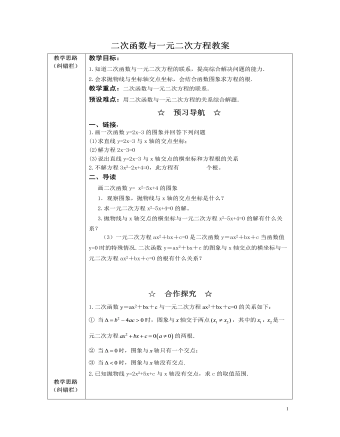
北师大初中九年级数学下册二次函数与一元二次方程2教案
教学目标:1.知道二次函数与一元二次方程的联系,提高综合解决问题的能力.2.会求抛物线与坐标轴交点坐标,会结合函数图象求方程的根.教学重点:二次函数与一元二次方程的联系.预设难点:用二次函数与一元二次方程的关系综合解题.☆ 预习导航 ☆一、链接:1.画一次函数y=2x-3的图象并回答下列问题(1)求直线y=2x-3与x轴的交点坐标; (2)解方程2x-3=0(3)说出直线y=2x-3与x轴交点的横坐标和方程根的关系2.不解方程3x2-2x+4=0,此方程有 个根。二、导读画二次函数y= x2-5x+4的图象1.观察图象,抛物线与x轴的交点坐标是什么?2.求一元二次方程x2-5x+4=0的解。3.抛物线与x轴交点的横坐标与一元二次方程x2-5x+4=0的解有什么关系?(3)一元二次方程ax2+bx+c=0是二次函数y=ax2+bx+c当函数值y=0时的特殊情况.二次函数y=ax2+bx+c的图象与x轴交点的横坐标与一元二次方程ax2+bx+c=0的根有什么关系?

人教版新目标初中英语九年级下册You’re supposed to shake hands教案
教学目标:1. 掌握本单元一些重点词汇的写法和用法。2. 学会自如谈论餐桌礼仪。Step 1 RevisionAsk some students to retell the customs at the table in France in the passage in 3a.Step 2 Self checkPart 1. Fill in each bland with the correct word given. Students do the exercises by themselves at first. Then check the answers. Ask the students to comprehend the sentences and help them point out uses of some words, like “arrive (at / in) sw., spend time / money on sth , spend time / money (in) doing sth.”Part 2. Read about Fan Ling’s experience in a western restaurant. Understand the passage. Point out some key points in the passage.1. be / get used to doing sth. 习惯做某事2. begin with = start with 以….开头3. crowd v. 挤满,塞满 the crowd 人群 crowded adj. 拥挤的Then students discuss about how she would solve her problem. Ask some to share their stories with others.Part 3. Complete the crossword by looking at the sentences on the left. Then check the answers.
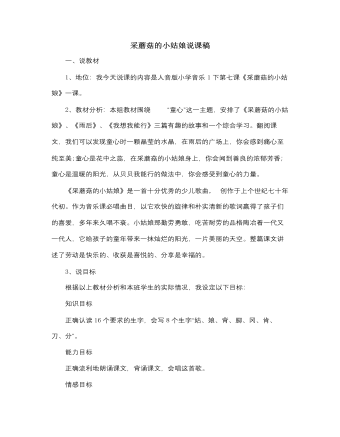
人音版小学音乐一年级下采蘑菇的小姑娘说课稿
(三)精读感悟1.独立阅读,自主探究。出示中心问题:这是一个---- 的小姑娘。?是从哪些地方看出来的?找出有关语句并体会着读一读。这一环节充分体现了学生“自主、合作、探究”的学习方式。教师为学生提供了宽广的学习空间。学生围绕中心问题,自己确定重点研究的内容,自由选择最适合自己的学习方式,在课文中摄取相关的语言信息。预设1这是一个勤劳的小姑娘,从第一小节看出。预设2这是一个善良的小姑娘,第二小节看出。引导学生找出相关的语句用自己的话说一说。设计意图1用尊重学生独特的见解和感受。让学生去关心文本中的人物,鼓励他们发表自己的想法,在品味中感受小姑娘的勤劳、善良故事表演情感升华2、学唱歌曲。帮助学生记忆课文。3、学完本课文后提问你最想说的一句话什么?你想对小姑娘说什么?达成情感目标。(四)达标测评(3)读一读,然后用“像”写句话。1.她采的蘑菇最多,多得像那星星数不清。2.她采的蘑菇最大,大得像那小伞装满筐。
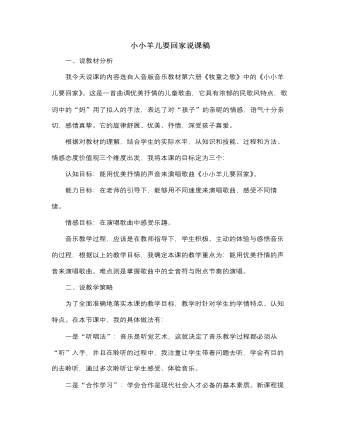
人音版小学音乐三年级下册小小羊儿要回家说课稿
(设计意图:给学生创设了一个愉快轻松的真情空间。这一环节给了学生大胆表达自己的感受,从各自不同的角度来感悟,培养了审美能力,使其积极性、自觉性、主动性得到了充分体现,活跃了课堂气氛,收到事半功倍的效果。至此,课堂推向高潮。最后,再次播放歌曲《小小羊儿要回家》,让孩子们把歌声带出教室,奔向属于他们的天地。五、教学说明各位老师、说话说:教学有法,但无定法,贵在得法。在本课教学设计中,我精心组织开放而有活力的课堂教学,尊重学生独特的情感与创造体验,始终贯穿“学生是学习和发展的主体”这一教育理念。采用多元化的教学手段,融音乐、表演为一体,发挥学生的创造能力,通过唱、听等丰富学生的情感体验,使学生的音乐审美素养得到全面提高,创设一个自由民主,宽松和谐,愉快互动的真情空间。突出学生活动、教师引导、共同探讨、总结求精的教学风格,使艺术课堂焕发勃勃生机。教学研究永无止境,我相信,没有最好,只有更好!
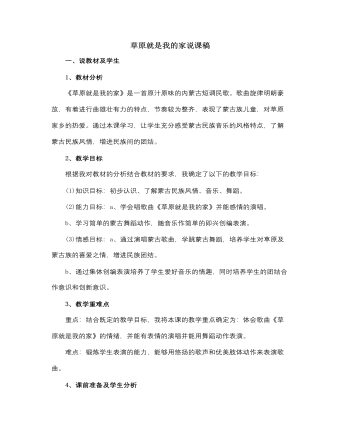
人音版小学音乐二年级下册草原就是我的家说课稿
1、通过师生问好律动,端正坐姿,投入课堂。(利用自然的节奏律动形式集中学生注意,引导学生在有节奏的模仿动作中自然的进入音乐学习)2、听音乐,猜歌名。通过聆听有关草原歌曲并说出歌曲名称,练习低年级学生的聆听、听辨音乐的能力,提高了学习兴趣,同时引出美丽的大草原。3、认识草原:通过讨论、看图片让学生初步认识了解大草原及蒙古族,引出课题)。4、结合课本与课件图片,说说美丽的大草原上有些什么?讨论小结:蓝蓝的天-、白白的云-、青青草地、牛羊多、骏马奔驰、雄鹰飞、还有善良的蒙古人。(这一环节以学生为主体,采用了看图片,师生讨论的学习方式,让学生在积极主动的去认识了解草原,最后通过有节奏的朗读明确小结了讨论内容,引导学生更好的认识草原,感受草原的美丽,培养学生的节奏感)
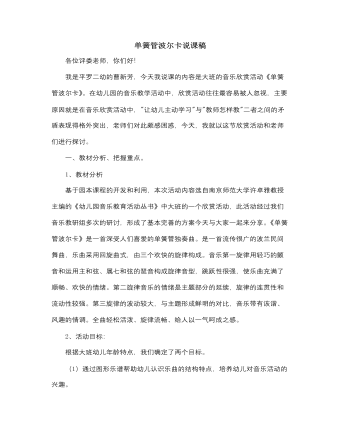
人音版小学音乐二年级下册单簧管波尔卡说课稿
在活动中只要不影响同伴,幼儿可以用各种动作,随着音乐旋律释放表演激情,而教师始终饱含热情,不断发现孩子的闪光点,并给予鼓励,让幼儿获得成功感。5、活动延伸:(1)与同伴手拉手一起随音乐跳圆圈舞。(2)邀请客人老师一起参与活动。这一环节的设计是将幼儿参与活动的积极性推向高潮,把自己对音乐的感受全部释放出来,再加上客人老师的参与使活动达到高潮,在烘托课堂气氛的基础上,达到了一个大家共同分享活动快乐的目的。6、听音乐走出活动室。六、感悟与反思:俗话说:"教无定法,贵在得法"一堂好的音乐欣赏课应该体现"教学生活化的"教育理念。我想,好的音乐欣赏应该是一种艺术享受,我会在以后的教学实践中,在新的教育理念的熏陶下,和孩子们一起探索,一起成长!本次活动有不当的地方,望各位老师给与批评指正,我的说课到此结束,谢谢!
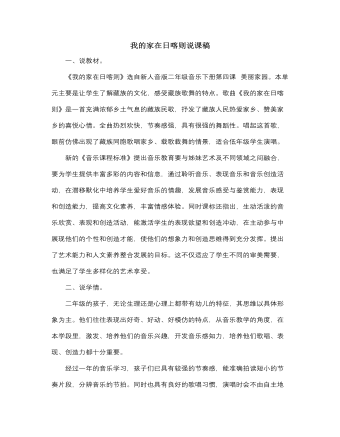
人音版小学音乐二年级下册我的家在日喀则说课稿
在学生情绪高涨时,我又让他们观看舞蹈《我的家在日喀则》,并引导他们观察其中最典型的动作,学生在熟悉的音乐中,再次体会藏族人民的热情、奔放,感受他们对家乡的热爱,并学跳藏族舞,用身体的动作感受踢踏舞的风格,将课堂气氛推向高潮。4、歌唱家乡(情感升华)。我引导学生卓玛姐姐想知道我们的家乡在哪里?也想到我们的家乡看看,自然将学生的思绪拉回重庆,让他们想想我们的家乡有什么很有特点,很有代表性的美景、美食,帮卓玛姐姐设计“重庆一日游”线路,借助图片让学生领略到家乡的美丽,自豪感油然而生。这时再引导学生歌唱家乡、赞美家乡,德育也就自然渗透其中,再次将课堂气氛推向高潮。最后,孩子们唱着自己创编的《我的家在重庆》走出教室,去迎接来自四面八方的朋友,结束本课教学。
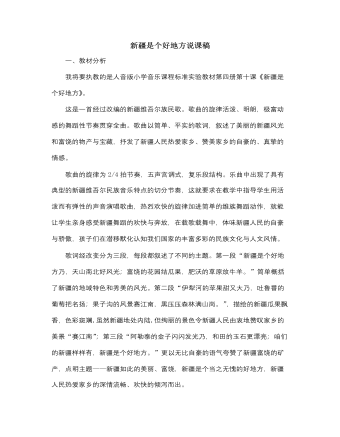
人音版小学音乐二年级下册新疆是个好地方说课稿
在学生热烈的讨论中,理解歌词,感悟新疆。并随机出示课件(课题 新疆是个好地方以及天山、伊犁河、吐鲁番、果子沟的图片)教师及时小结“在新疆这片美丽的土地上,大自然也创作出了它的杰作,用它那神奇的力量,为新疆人民开辟了一处圣地——天山。天山是新疆最大的一条山脉,峰顶白雪皑皑。它是新疆的象征。”在引领学生有感情的朗读歌词时,重点指导学生“乃”字要读轻声才好听。学生按节奏读第二段歌词,教师告诉提醒学生注意一字多音的地方要读正确,如“伊犁河”“果子沟的”等。再次,教师有感情地范唱。教师用语言调动学生的积极性,如“大家读的真有感情,我都忍不住要唱起来了,大家想听吗?如果你觉得老师唱的好听就请拍手为我伴奏吧!”“老师唱的好听吗?相信你们比老师唱的更好听,想不想跟我比一比啊?”
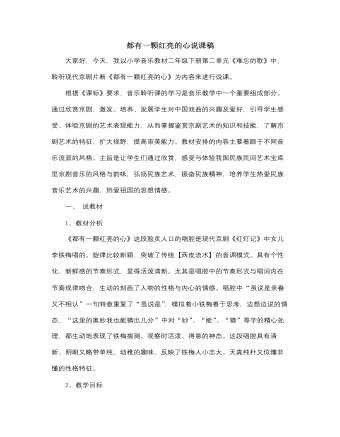
人音版小学音乐二年级下册都有一颗红亮的心说课稿
师介绍念白主要分京白和韵白:京白是经过艺术加工的北京方言,节奏鲜明,重点突出。韵白具有一种典雅而夸张的韵味,是对古代人物语言的艺术变形。(用《红灯记》中李奶奶的一句话:“你姓陈,我姓李,你爹他姓张!”示范用京白,韵白念后,带学生用京白学念两遍。)(五) 再听现代京剧片段《都有一颗红亮的心》1. 引导学生结合音乐欣赏,初步了解感受其唱腔特点。师:京剧主要两大唱腔(二黄原板与西皮流水),今天我们来了解下“西皮流水”唱腔的点:投影西皮流水是一种节奏紧凑;旋律起伏变化比较大;唱腔明朗、活泼、流畅;善于表现喜悦、激动、高昂的情绪唱腔。(六)课堂小结京剧是博大精深的,这节课仅仅给同学们起到了引导作用,希望这节课能成为我们热爱京剧的良好开端,让我们打开京剧大门,一起去真正揭开京剧神秘的面纱,做一个自豪的中国人。
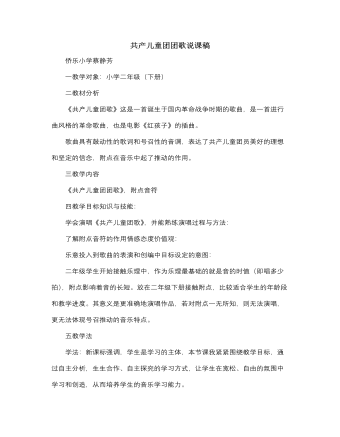
人音版小学音乐二年级下册共产儿童团团歌说课稿
A全曲分几段,你觉得一共有多少句?二段四句(二年级学生才刚开始接触乐理,先用简浅的段,句关系分析音乐,待四年级再介绍曲式结构)B比较13。125和13125老师:哪个更能够表达出儿童昂扬的精神风貌?学生:第一个教师:为什么呢?第一个和第二个的区别在于哪个地方?学生:点引出附点在音乐中起到的作用C比较教师以钢琴演奏抒情风格和进行曲风格的《共产儿童团歌》,哪个版本更激动教师:为什么进行曲风格的比较激动,两个版本的区别在于哪里?学生:快,慢教师:歌曲的风格除了考音符的形式(附点音符)表现以外,还有速度,速度可以该改变歌曲的风格。D换形式演唱以对答的形式演唱歌曲,加深印象(三)拓展最后,老师希望你们能够发挥自己的创意,为这首激动的《共产儿童团歌》加入动作或者是选择任意的乐器来配乐伴奏。
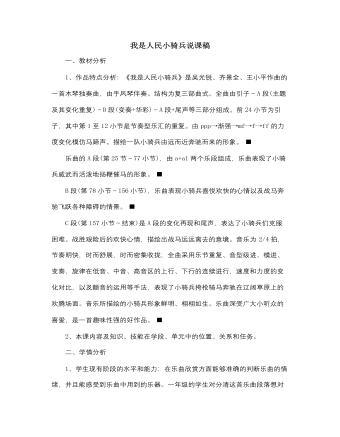
人音版小学音乐二年级下册我是人民小骑兵说课稿
教师与学生有导有游,避免了以往欣赏课教学中枯燥的让学生完整听,分段听,机械式的讨论欣赏,增加了情趣,用不同的音乐活动表现不同的段落,让学生清晰各个段落的旋律与表现内容。2、本课成功之处:创设良好的学习情境,营造良好的学习氛围。学生在学习过程中,通过舞蹈、器乐伴奏等表演感受到了音乐段落的变化,学生清楚的分清段落层次。3、本课失败之处:舞蹈动作的创编如果能更加生动,体现出小骑兵的神气活现会更好。4、生成问题:学生在合作表演时,打击乐器的节奏容易不稳,教师提醒学生注意的同时可以带领学生一起敲击控制好节拍。最后为了丰富学生对音乐的体验,我在这一部分让学生通过欣赏歌曲《草原英雄小姐妹》,感受蒙古音乐的节奏特点,体验并升华情感。5、今后调整思路:舞蹈动作可以创编更生动更有表现力的动作,丰富学生的感受和表现力。
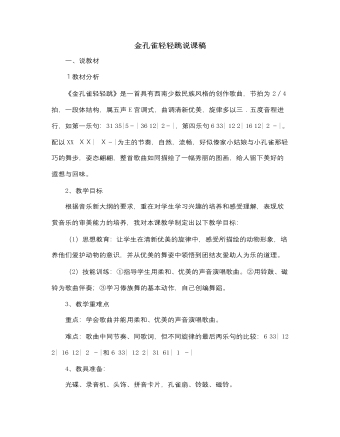
人音版小学音乐二年级下册金孔雀轻轻跳说课稿
4、大胆尝试,用柔和优美的声音演唱歌曲。在熟悉节奏旋律后,解决了难点的基础上,学生对歌曲的学习已是轻松自如了。在此过程中,我采用多种形式让学生练习唱歌:齐唱、分组唱、分男女生唱、个别演唱等多种演唱形式,充分发挥学生的演唱才能。5、成立简易乐队。在唱好了歌的基础上,激发学生用一些简易乐器为歌曲伴奏,利用铃鼓、磁铃为歌曲伴奏。老师用铃鼓示范,磁铃主要用在打击长音处。学生分组练习用铃鼓和磁铃为歌曲伴奏。这样,既培养学生的节奏感,也使他们有一定的成就感。6、创编活动:美的旋律、美的歌词更需要美的舞姿。为了激发学生学舞的兴趣,老师随音乐表演一段,然后重点把傣族的几个基本动作给学生示范一次:孔雀鹤立、孔雀开屏、傣族舞语汇,鼓励学生三五个一组,互相启迪、创作,老师指导、观察,请一些创编的好的同学在前边来表演,音乐再次响起,让每一个学生都动起来,各尽其能、各得其乐、各有所获。整节课都让学生处于愉悦之中。

